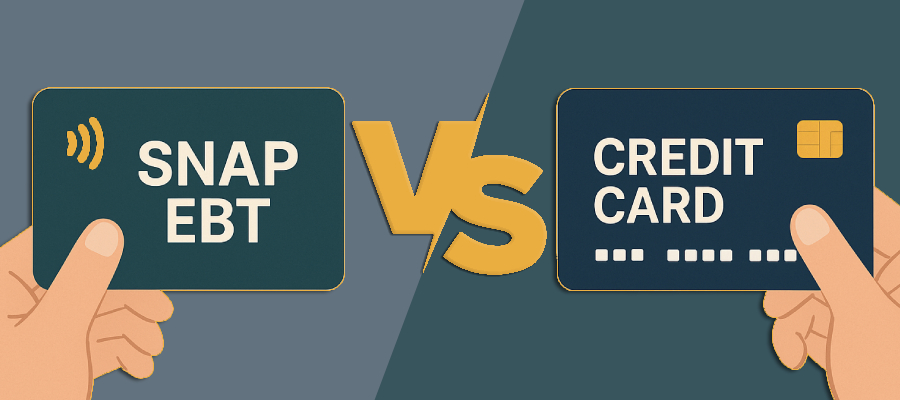Why SNAP and Credit Cards Are Not the Same
There is a growing tendency to compare the Supplemental Nutrition Assistance Program (SNAP), distributed through Electronic Benefit Transfer (EBT) cards, with ordinary credit cards. The argument usually arises during discussions about government spending or poverty assistance, with someone asserting, “What’s the difference? Both are plastic cards used to buy food.” It sounds simple, but the equivalence falls apart the moment we examine how these systems actually work, what they represent, and who truly pays.
To begin with, SNAP and EBT are not instruments of personal credit but tools of public welfare. The funds on an EBT card are not earned or borrowed; they are provided by the government, which is funded by the taxpayer. In other words, these funds are allocated from tax revenue, which is money collected from individuals who work, produce, and pay taxes, and then redistributed through government channels to those who qualify for assistance. The card is merely a delivery mechanism, much like a key that opens a pantry stocked by others. When the card is swiped, it does not initiate a transaction between a buyer and a lender but between a recipient and the taxpayer who supplied the resource.
A credit card, on the other hand, is an instrument of private exchange and debt. The bank or credit institution extends a line of credit based on the cardholder’s perceived ability to repay the debt. The transaction involves risk, responsibility, and a direct agreement between lender and borrower. When you swipe a credit card, you are spending your future earnings, and you are legally bound to repay them with interest. The entire mechanism relies on trust, personal accountability, and the borrower’s credibility.
The distinction matters because it defines the nature of the relationship between the individual and society. A credit card operates within a market economy, where voluntary exchange and repayment create circulation and growth. EBT operates within a redistribution system, where the flow of resources moves from producers to recipients through compulsion rather than market exchange. This is not an insult to those who rely on assistance; it is simply the way the system works. The funds are not self-generated, nor are they borrowed against future productivity. They are drawn from the collective output of others.
Understanding this difference clarifies who truly pays. With a credit card, a taxpayer pays with their money, their time, and their reputation. With an EBT card, a taxpayer pays via the taxes thrust upon them by the government. In this scenario, someone else’s labor is converted into sustenance for the recipient. To conflate the two is to blur the line between earned credit and public entitlement, between obligation and charity.
The distinction is not merely academic. When citizens confuse EBT for credit, they unconsciously erase the concept of contribution. If all forms of exchange are treated as equal, then there is no moral or civic difference between producing and consuming, between earning and receiving. This confusion feeds political narratives that treat redistribution as a right rather than a stopgap, a short-term bridge intended to help individuals regain self-sufficiency. Accordingly, when such confusion arises, it is important to help the confused understand the differences.
So, when the topic surfaces in a heated debate, it helps to bring the conversation back to first principles. A reasonable response might sound like this: “Both may be plastic, but one represents what you have earned and agreed to repay. The other represents what someone else earned, and the government redistributed. They are not the same thing.” The tone does not need to be cruel or accusatory. Facts carry their own gravity when presented plainly.
Or, if the goal is genuine understanding rather than partisan point-scoring, it might be helpful to ask questions rather than make declarations. A few examples might be, “Who funds it?” “Who assumes the risk?” “What happens if the cardholder fails to repay?” Such questions expose the functional difference without moralizing the issue. They invite thought rather than reflex.
Ultimately, the confusion between SNAP and credit cards shows something larger about our cultural psychology. Too many people conflate equality of opportunity with equality of outcome, and equality of need with equality of effort. The mechanisms of exchange, whether market or government, reflect the values that sustain a society. SNAP and EBT are supposed to reflect compassion and social responsibility, although that line gets pushed back every day. Either way, Credit is supposed to reflect trust, responsibility, and accountability. Both have value, but they are definitely not interchangeable.
Recognizing the difference restores clarity to a conversation that has become clouded by emotion. That said, I should mention that SNAP is not inherently evil, nor is credit inherently virtuous. But they definitely exist on opposite ends of a moral and economic spectrum: one redistributes the fruits of production, the other depends on the promise of future production. Understanding that difference is not just an economic exercise, it’s a civic one.
Keep Learning! Check out my article, History Lesson: Stupidity as a Weapon of Control




